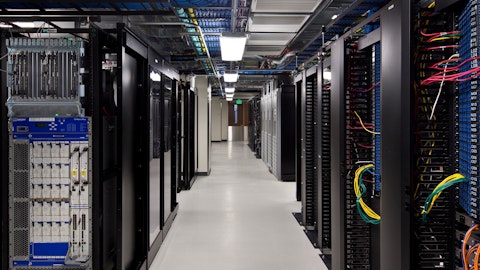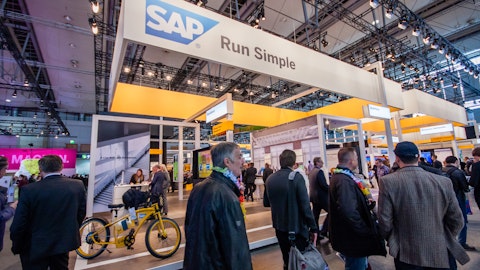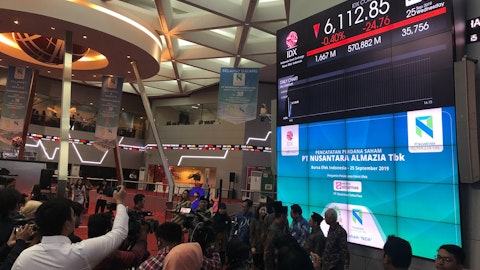SAP SE (NYSE:SAP) Q2 2023 Earnings Call Transcript July 20, 2023
SAP SE beats earnings expectations. Reported EPS is $3.14, expectations were $1.17.
Operator: Ladies and gentlemen, thank you for standing by. Welcome, and thank you for joining the SAP Q2 2023 Earnings Conference Call. [Operator Instructions]. I would now like to turn the conference over to Anthony Coletta, Chief Investor Relations Officer. Please go ahead.
Anthony Coletta: Good day, everyone, and welcome. Thank you for joining us. With me today are CEO, Christian Klein; CFO, Dominik Asam and Scott Russell, who leads Customer Success. On this call, we will discuss SAP’s Q2 and first half 2023 results. You can find the deck supplementing this call as well as our quarterly statement on our Investor Relations website. During this call, we’ll make forward-looking statements, which are predictions, projections or other statements about future events. These statements are based on current expectations and assumptions that are subject to risks and uncertainties that could cause actual results and outcomes to materially differ. Additional information regarding these risks and uncertainties may be found in our filings with the Securities and Exchange Commission including, but not limited to the Risk Factors section of SAP’s annual report on Form 20-F for 2022.
Unless otherwise stated, all numbers on this call are non-IFRS and growth rates, percentage point changes and our 2023 financial outlook are non-IFRS at constant currencies. The non-IFRS financial measures we provide should not be considered as a substitute for or superior to the measures of financial performance prepared in accordance with IFRS. Before we start, I would like to remind you that SAP completed the sale of its stake in Qualtrics in June of this year. Therefore, all figures shared on this call are based on SAP Group results from continuing operations. And with that, I’d like to turn the call over to Christian.
Christian Klein: Yes. Thank you, Anthony. And as always, thanks for joining us for our earnings call today. This has been a good Q2. At the halfway point of 2023 SAP continues to perform well despite a macroeconomic environment that remains uncertain. After reaching the turning point in our transformation, our sharpened focus has yielded real momentum, and we are seeing strong demand across our portfolio. Customers are looking to our game-changing solutions to foster sustainable end-to-end business processes across diverse industries on a global scale. It is also worth pausing on the watershed moment we’re experiencing with generative AI. It’s clear that generative AI will fundamentally change the way businesses run. In the business world, no one is better positioned than SAP to empower businesses to take advantage of this transformational moment, giving them the solutions to harness AI to improve business outcomes.
We believe we are uniquely placed to become the leader in business AI. At our most recent Sapphire conference in May, we shared specifics of our AI approach with SAP Business AI. later on in my remarks today, I will talk in more detail about our ambitions on this front. So let’s first turn to the summary of our numbers. In Q2, operating profit grew at an impressive 28%, up from 12% in Q1, clearly demonstrating the strength of this new phase in our transformation. This puts us in a strong position as we work towards our goal of double-digit operating profit growth in 2023. Current cloud backlog stands at over €11.5 billion, with continued strong growth, up 25% this quarter. Cloud revenue continues to grow steadily at 22%. And total Q2 revenue grew at 8%.
For S/4HANA, specifically, cloud revenue grew 79%, up from 75% in Q1 and current cloud backlog grew 70%. Our results this quarter demonstrate the strength of our solutions in addressing the specific needs of our customers during challenging times. Customers are choosing SAP to help them transform their business processes, collaborate across their supply chain and operate sustainably. RISE with SAP continues to be the preferred choice for customers adopting the SAP portfolio to transform the end-to-end business processes in the cloud. Key new RISE deals this quarter include Bayer AG and Bacardi-Martini. As one of the world’s largest pharma and biotech companies, Bayer chose RISE with SAP to facilitate its extensive business transformation program known as Core.
While Bacardi is the world’s largest privately owned international spirits company with a portfolio of more than 200 brands. They have chosen RISE with SAP to meet their ambitious growth targets. There were also a number of important RISE Go Live this quarter, including HanesBrands, Levi’s, Tech Mahindra and Versuni. Tech Mahindra of India deployed RISE with SAP in record time, going live in just 3.5 months. Versuni, a new company formed from Philips Domestic Appliances undertook one of the largest RISE transformations ever, and it was completed in just 18 months. The success of RISE with SAP is clear. This is SAP’s signature offering, which helps customers move to the cloud and transform their business processes at the same time. It’s also very important to emphasize that SAP’s newest innovations and capabilities will only be delivered in SAP public cloud and SAP private cloud using RISE with SAP as the enabler.
This is how we will deliver these innovations with speed, agility, quality and efficiency. Our new innovations will not be available for on-premise or hosted on-premise ERP customers on hyperscalers. For example, new ERP capabilities as well as sustainability and carbon accounting solutions, and all our new AI innovations will only be available in the cloud and delivered via RISE and GROW with SAP. Last quarter, we introduced the powerful new offering, GROW with SAP, designed for mid-market customers who are new to SAP and likely to be growing quickly as they build their businesses. GROW has quickly become popular just RISE with SAP, for which around half of the customers are net new to the SAP family. The momentum I’ve described with both RISE and GROW with SAP is underpinned by the SAP business technology platform.
This is the foundation for integration and extensibility across our portfolio. We have reached an important milestone this quarter with over 20,000 live BTP cloud customers. This quarter, new wins included Visa, the world leader in digital payments; and Santander, the Spanish financial multinational who are using SAP business technology platform to revolutionize and streamline the banking experience. Increasing adoption of S/4HANA and the SAP business technology platform is also driving significant cross and upsell opportunities across our portfolio. Let’s now discuss the latest updates to our approach with SAP Business AI. As I said earlier, we believe we are uniquely placed to become the leader in AI built for business. Customers will benefit from new AI-powered solutions that step change how processes can self-learn and self automate to self-optimize business outcomes.
For example, imagine supply chains that automatically initiate a different delivery route based on weather and congestion data. There will be a step change in how employees can interact with solutions in vertically more efficient and personalized ways. For instance, imagine your ERP system using embedded ESG data and business data to decarbonize the supply chain by 5%, simply by asking for it. And there will be a step change in uncovering new insights that lead to better business decisions. Imagine one trusted data layer across your entire company that enables AI to pull together the wide data in seconds. This will bring us significant opportunities for market expansion through new AI-based solutions and new premium offerings. Based on external forecasts and our own calculations, we see a potential doubling of our addressable market to $1 trillion by 2028 with AI being a key contributor.
We will be introducing new premium RISE offerings with an uplift of up to 30% in the fall. Our approach with SAP Business AI is unmatched in the industry, delivering our customers the most relevant, reliable and responsible AI built for business. Firstly, our AI is relevant because it’s embedded into every part of our portfolio. More than 24,000 SAP cloud customers today can already use SAP business AI across hundreds of built-in AI capabilities and partner use cases. To provide a couple of new tangible examples. In SAP Transportation Management, generative AI will save up to 55% of the processing cost of delivery notes. The new intelligent collections in SAP S/4HANA Finance can reduce the time between invoice and payment by up to 10%. Secondly, based on unique business data and business process context, we can deliver the most reliable business AI.
Reliable AI hinges on applying the wide data to the wide model. By using SAP DataSphere to leverage substantial contact switch industry-specific data, business AI system can drastically improve accuracy, generate more relevant content and minimize AI hallucinations. Thirdly, responsible AI is not a buzzword for us. Our customers trust us with their most critical data and can confidently deploy our AI offerings, knowing we prioritize the highest levels of security, privacy, compliance and ethics. We comply with the highest standards when it comes to customer consent, security, GDPR regulations. This is what SAP stands for. We will continue to innovate and deliver by creating an AI ecosystem for the future, combining SAP and partner innovation built on the SAP business technology platform.
Let me give you some examples of this approach. At SAP Sapphire, we announced a partnership with Microsoft to collaborate on joint generative AI offerings to help customers address the talent gap with new recruitment and development tools. Last week, SAP Sapphire Ventures, the technology-focused we see backed by SAP announced that it will dedicate USD 1 billion to AI-powered enterprise technology start-ups. Earlier this week, we announced strategic investments in 3 leading generative AI companies, Aleph Alpha, Anthropic, and Cohere. In the fall, we plan to announce new AI solutions and capabilities across our portfolio. All told, we see a huge opportunity with new innovation in AI and believe SAP is uniquely poised to help customers take advantage of this watershed moment.
As our Q2 results show, SAP continues to deliver. We are optimistic about the future based on SAP’s core value, delivering technologies that build stronger companies. As we start the second half of the year, we remain fully committed to delivering on our promise of accelerated revenue and profit growth. This is reflected in our increased guidance for cloud and software revenue and for operating profit. In closing, let me quickly look back on what we have accomplished in recent years. Our own transformation into a cloud company, our leaner and more agile operating structure, new offerings that bring the power of SAP to more companies, solutions that harness the power of data wherever it resides and tools that create sustainable business processes across the industries.
Now is another threshold moment. While nearly every company is working on the AI revolution in some way, no one sits at the nexus of technology and business like SAP. And we think there is enormous opportunity ahead. Dominique, over to you.
Dominik Asam: Thank you, Christian, and good afternoon, everyone. We are very pleased with our second quarter’s growth in non-IFRS operating profit, putting some upward pressure on our outlook on that metric for the full fiscal year 2023. In Q2, we also maintained a steady growth of our cloud business with current cloud backlog and cloud revenue, again growing by 25% and 22% year-over-year, respectively. The trend towards larger cloud transactions continued with deals greater than €5 million volume contributing to nearly half of our cloud order entry. As a reminder, on June 28, SAP completed the sale of its stake in Qualtrics. Therefore, the following results are for continuing operations. Let me talk you through our financial performance in more detail.
Current cloud backlog was €1.5 billion, growing by 25% with S/4HANA, current cloud backlog growing by 70%, driven by the continued strong adoption of RISE with SAP. Our combined SaaS and PaaS portfolio continue to grow by 26%, with SaaS cloud revenue up 22% and PaaS cloud revenue up 45%. The sustained momentum was again fueled by the strong contribution of S/4HANA cloud and the business technology platform. Software licenses revenue saw a decrease by 24%. Total revenue was up 8% year-over-year, demonstrating the great resilience of our overall business in the current macro environment. Now let’s take a brief look at our regional performance. In the second quarter, all regions delivered strong cloud performance. Germany, Brazil and India had outstanding cloud revenue growth, while the United States, the Netherlands, France, China and Chile performed particularly strong.
Now moving further down the income statement. Our cloud gross profit grew by 24%, supported by the completion of SAP’s next-generation cloud delivery program. This marks a key milestone in terms of portfolio integration and harmonization for our customers. This, in turn, resulted in cloud gross margin improving from the year ago period, expanding by 1.1 percentage points to 72.2%. In the second quarter, both IFRS as well as non-IFRS operating profit increased by 28%, mainly driven by sustained high growth in cloud revenue, the completion of the next-gen cloud delivery program, efficiency gains resulting from spending discipline across the entire organization as well as gradual relief from the impacts of the war in Ukraine. Additionally, our IFRS operating profit benefited from restructuring expenses in Q2 last year but was negatively affected by higher share-based compensation expenses primarily due to share price development over the quarter.
Finally, the operating margin landed at 27.2%, a 4.4 percentage point improvement compared to the prior period. Earnings per share in the quarter increased 12% to €1.07. The IFRS effective tax rate for Q2 was 33.8%, and the non-IFRS tax rate was 30.4%. The reduction of the IFRS effective tax rate from Q1 to Q2 mainly resulted from the increase in profit before taxes. Now looking to our cash generation. Free cash flow for Q2 significantly increased to €604 million, driven by the strong expansion of operating profit and the reduction of payments, primarily for share-based compensation but also for CapEx and leasing. Now let’s move on to our financial outlook. As you’ve seen in today’s release, we are updating our revenue and operating profit outlook for the full year for continuing operations.
The outlook range for cloud and software revenue is being narrowed by moving the lower end slightly up despite moving the upper end of the range for cloud revenues down. The latter being mainly driven by lower-than-anticipated transactional revenue. As a result of this slight shift in mix and overall marginally higher midpoint of our cloud and software revenue outlook, the operating profit outlook range has been increased accordingly. Note that this update implicitly leaves the overall margin profile intact for the year and provides confidence in achieving the free cash flow outlook, which is reaffirmed. As you know, our 2023 financial outlook is based on constant currency assumptions, i.e., a prior year’s exchange rate of USD 1.05 per euro.
Let’s now discuss our nonfinancial targets. The nonfinancial outlook for 2023 is reiterated. In Q2, SAP once again achieved net carbon emissions of 0-kilotons. Our focus continues to be on reaching net zero emissions across our value chain by 2030. To get there, we’re establishing a multiphase supply chain engagement program with our suppliers to significantly reduce our upstream greenhouse gas emissions. As a first step, we are working with our top 100 suppliers to ensure they report emissions at product level and follow a net zero plan, leveraging our own technology to do so. Our first half results give us confidence that we are heading in the right direction and continue to be well established and positioned to achieve our revenue and profit growth goals for the year.
The resilience of our businesses, combined with the focus and cost discipline across the organization are evidenced by strong profit growth. Q2 results continue to demonstrate that SAP has entered the second phase of its transformation, characterized by sustained cloud momentum, now turning into significant profit growth. In addition, we are laser-focused on our core and continue to streamline the business as demonstrated by our successful divestiture of Qualtrics in the last quarter. We firmly believe that we offer best-in-class solutions to our customers, serving as a trusted strategic partner in their digital transformation journey. Thank you, and we will now be happy to take your questions.
Anthony Coletta: All right. [Operator Instructions]. So operator, please open the line.
See also 30 Most Polluted Cities in the U.S. and 10 Best Gold Royalty Stocks to Buy Now.
Q&A Session
Follow Sap Se (NYSE:SAP)
Follow Sap Se (NYSE:SAP)
Operator: [Operator Instructions]. And the first question comes from the line of Toby Ogg with JPMorgan Cazenove Limited.
Toby Ogg: Yes. Perhaps just firstly on the cloud revenue side, Dominik, you mentioned the transactional revenues varies as the driver of the shortfall. Could you just give us a sense for what you’re seeing there with respect to those transactional revenues? And whether you’re seeing any other macro headwinds across any of the other lines of business applications outside of S/4HANA?
Dominik Asam: So I think on the transaction side, you know what types of businesses are in there. It’s the kind of travel expense Concur Tool, external workforce, contingent labor, Fieldglass, business network transactions. And where we really took a little bit of hit was on the Fieldglass contingent workforce side. There, indeed, the macro with low flows and reduced levels of contingent workforce was actually slightly shrinking. So that was a little bit of a headwind, which was not expected to that degree. Otherwise, I’d say it’s pretty much in line.
Christian Klein: I guess, Toby, maybe just to build on that, and Scott can also give a sentiment on the pipeline. I mean, being out there, we definitely see no slowdown in our SaaS and PaaS business. I mean S/4HANA, the cloud revenue even accelerated once again. The PGP, the platform sees more and more adoption. Now also with the clean core. It’s not only very important for the integration but also for building the extensions for new — building new apps either by our customers, partners or SAP. And then thirdly, I mean, for half year, too, also, when you look at the geopolitics, I guess, we see really strong demand also still relying on SAP in order to be able to do business in over 130 countries. So just coming back from China, we see a huge demand on software of doing business in China for China.
Or when you look at the utilities or retail and auto, I mean, they continue that transformation full speed and you need the ERP supply chain procurement systems in order to run these new businesses. And then last but not least, as we are building already hundreds of UI use cases for machine learning and embedding that with generative AI, we definitely also see now stronger demand on also moving out to the next-generation ERP in the cloud because only there, our customers can consume all these new innovations. So that will help as well to drive further momentum in half year, too.
Operator: Next question is from the line of Frederic Boulan with Bank of America.
Frederic Boulan: A question on the balance sheet now that Qualtrics is now closed. Any further thoughts on what’s the optimal leverage for SAP was the right capital allocation? Would you consider increasing the €5 million buyback absent any large M&A opportunities or we want to keep powder dry considering opportunities in AI and elsewhere?
Dominik Asam: Yes. Indeed, our balance sheet right now is very strong. I think we have snapped back to a net cash position of €4.2 billion. We’ve already announced that the lion’s share of the proceeds will be invested in a share repurchase, which will stretch through 2025. And this will be commenced very shortly. So for the time being, let’s also look at what opportunities there might be on the M&A side for the time being. I don’t want to kind of make more commitments than what we have already said with regards to the €5 million share repurchase, but it is true that we have a very strong balance sheet and are very much able to act.
Operator: The next question comes from the line of Adam Wood with Morgan Stanley.
Adam Wood: I wanted to come back to that subject of AI. I wonder if you could talk a little bit about how you’re applying AI internally? And what cost benefits you see from that, and how that balances against the need for you to increase R&D investments to deliver on the AI functionality you’re talking about putting in apps? And could you talk a little bit about how the time frame of delivering on those two things might be different and one might come before the other?






